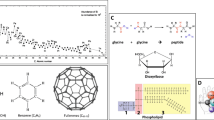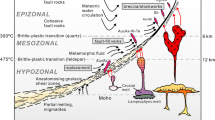Abstract
Carbonaceous chondrite meteorites are primitive asteroidal fragments that contain organic carbon and offer a glimpse of the a-biotic chemical processes that preceded the onset of terrestrial life. Their organic materials display structures as diverse as kerogen-like macromolecules and simpler soluble compounds with identical counterparts in Earth’s biosphere. All show an isotopic composition that verifies their extraterrestrial origin and a lineage to cosmochemical synthetic regimes. While the origin of life remains an inscrutable event, the natural samples of meteorites offer means for learning the range of abiotic molecules available to prebiotic chemistry as well as to explore the physico chemical regimes that might have led to a selected chemical pool amenable to the onset of life.




Similar content being viewed by others
Notes
We should remember that the very question of life’s origin was not possible before 1864, when Pasteur demonstrated that the microorganisms growing in the fermentation of broths came from the surrounding air. Until then, the explanation had been that of their spontaneous generation. This idea had carried from antiquity and crossed unquestioned the Middle Ages and Renaissance (at least in regard to bacteria, Newton, Descartes, and Bacon believed in it). Pasteur’s experiment meant that life, deriving from pre-existing life, must have a history and an origin. Where did it all begin?
Meteorites receive their name from the locality in which they fall and are designated as falls when the fireball accompanying their entry into the atmosphere is observed and their fragment are collected soon after; usually, all pertinent atmospheric details are also recorded. Finds are those meteorites that are found on the ground; in the case of CC fallen in temperate climates, they may have acquired substantial terrestrial contamination.
Albeit being 5 years old, this 2006 reference represents the last comprehensive review of CC organic composition. All unreferenced reports are referred to it.
Based on the cyclotron frequency of the ions in a fixed magnetic field.
Chirality is best understood by the synonym of handedness because it indicate objects that, like the left and right hands, come in two forms made up of equal components that are mirror images of each other but do not superimpose.
Recent work (Pizzarello and Groy 2010) has shown L-ee for lactic acid in several meteorites. This finding was also confirmed by isotopic analyses, however, it represents the only case of ee between hydroxyacids.
The number accompanying the meteorite’s family abbreviation indicates the extent of its parent body petrological alteration by water (on scale from 3 to 1, where 3 is least altered).
δ‰ = (R sample − R standard/R standard) × 103, for hydrogen, R = 2H(D)/H and the standard is mean ocean water.
References
Chyba CF, Sagan C (1992) Endogenous production, exogenous delivery, and impact-shock synthesis of organic molecules: an inventory for the origins of life. Nature 355:125–132
Cleland CE, Chyba CF (2002) Defining ‘life’. Orig Life Evol Biosph 32:387–393
Crisma M, Moretto A, Formaggio F, Kaptein B, Broxterman QB, Toniolo C (2004) Meteoritic Cα-methylated α-amino acids and the homochirality of life: searching for a link. Angew Chem Int Ed 43:6695–6699
Cronin JR, Pizzarello S (1997) Enantiomeric excesses in meteoritic amino acids. Science 275:951–955
Cronin JR, Reisse J (2005) Chirality and the origin of homochirality. In: Gargaud M (ed) Lectures in astrobiology. Springer, Berlin, pp 473–515
Cronin JR, Pizzarello S, Frye JS (1987) 13C NMR spectroscopy of insoluble carbon in carbonaceous chondrites. Geochim Cosmochim Acta 51:299–303
Engel MH, Macko SA (1997) Isoptopic evidence for extraterrestrial non racemic amino acids in the Murchison meteorite. Nature 389:265
Hayatsu R, Winans RE, Scott RG, McBeth RL, Moore LP, Studier MH (1980) Phenolic ethers in the organic polymer of the Murchison meteorite. Science 207:1202–1204
Hsieh HH, Jewitt DC (2006) A population of comets in the main asteroid belt. Science 312:561–563
Keller JW et al (1990) Pseudomonas cepacia 2, 2-Dialkylglycine decarboxylase: sequence and expression in Escherichia coli of structural and repressed genes. J Biol Chem 265:5531–5539
Kvenvolden K, Lawless J, Pering K, Peterson E, Flores J et al (1970) Evidence of extraterrestrial amino acids and hydrocarbons in the Murchison meteorite. Nature 228:923–926
Leman L, Orgel L, Ghadiri MR (2004) Carbonyl sufide-mediated prebiotic formation of peptides. Science 306:283–286
Oro’ J, Guidry CL (1961) Direct synthesis of polypeptide I. Polycondensation of glycine in aqueous ammonia. Arch Biochem Biophys 93:166–171
Pizzarello S, Weber AL (2004) Meteoritic amino acids as asymmetric catalysts. Science 303:1151
Pizzarello S, Huang Y (2005) The deuterium enrichment of individual amino acids in carbonaceous meteorites: a case for the presolar distribution of biomolecules precursors. Geochim Cosmochim Acta 69:599–605
Pizzarello S, Holmes W (2009) Nitrogen-containing compounds in two CR2 meteorites: 15N composition, molecular distribution and precursor molecules. Geochim Cosmochim Acta 73:2150–2162
Pizzarello S, Weber AL (2010) Stereoselective syntheses of pentose sugars under realistic prebiotic conditions. Orig Life Evol Biosph 40:3–10
Pizzarello S, Groy TL (2011) Molecular asymmetry in extraterrestrial organic chemistry: an analytical perspective. Geochim Cosmochim Acta 75:645–656
Pizzarello S, Zolensky M, Turk KA (2003) Non racemic isovaline in the Murchison meteorite: chiral distribution and mineral association. Geochim Cosmochim Acta 67:1589–1595
Pizzarello S, Cooper GW, Flynn GJ (2006) The nature and distribution of the organic material in carbonaceous chondrites and interplanetary dust particles. In: Lauretta DS, McSween HY Jr (eds) Meteorites and the early solar system II. University of Arizona Press, Tucson, pp 625–651
Pizzarello S, Huang Y, Alexandre MDR (2008) Molecular asymmetry in extraterrestrial chemistry: insights from a pristine meteorite. Proc Natl Acad Sci USA 105:7300–7304
Pizzarello S, Williams LB, Lehman J, Holland G, Yarger JL (2011) Abundant ammonia in primitive asteroids and the case for a possible exobiology. Proc Natl Acad Sci USA 108:4303–4306
Rodgers SB, Charnley SB (2008) Nitrogen superfractionation in dense cloud cores. Mon Not R Astron Soc 569:L48–L52
Roueff E, Gerin M (2003) Deuterium in molecules of the interstellar medium. Space Sci Rev 106:61–72
Schmitt-Kopplin P, Gabelica Z, Gougeon RD, Fekete A, Kanawati B et al (2010) High molecular diversity of extraterrestrial organic matter in Murchison meteorite revealed 40 years after its fall. Proc Natl Acad Sci USA 107:2763–2768
Weber AL, Pizzarello S (2006) The peptide-catalyzed stereospecific synthesis of tetroses: a possible model for prebiotic molecular evolution. Proc Natl Acad Sci USA 103:12713–12717
Yabuta H, Williams LB, Cody GD, Alexander CMOD, Pizzarello S (2007) The insoluble carbonaceous material of CM chondrites: a possible source of discrete organic compounds under hydrothermal conditions. Meteor Planet Sci 42:37–48
Acknowledgments
The author’s work described in this article has been supported from the National Aeronautic and Space Administration, through grants by the Astrobiology & Exobiology, Cosmochemistry and Origins of the Solar System programs. Meteorite stones were provided by Carleton Moore and Laurence Garvie from the Center for Meteorite Studies at Arizona State University (Murchison) and Cecilia Satterwhite, Kevin Righter and the Antarctica Meteorite Working Group (CR2s).
Author information
Authors and Affiliations
Corresponding author
Rights and permissions
About this article
Cite this article
Pizzarello, S. Prebiotic chemical evolution: a meteoritic perspective. Rend. Fis. Acc. Lincei 22, 153–163 (2011). https://doi.org/10.1007/s12210-011-0124-6
Received:
Accepted:
Published:
Issue Date:
DOI: https://doi.org/10.1007/s12210-011-0124-6




